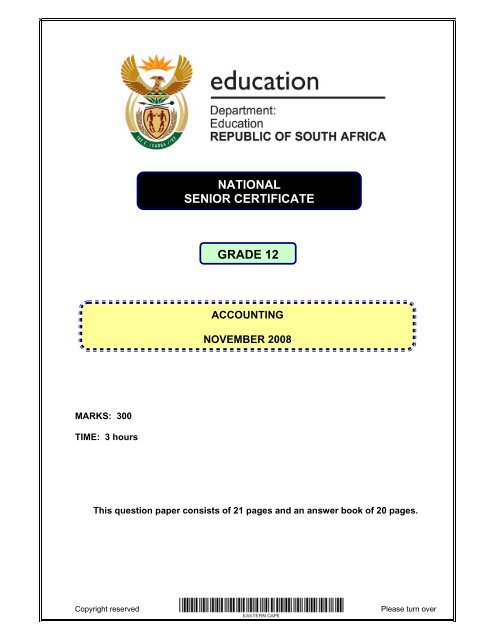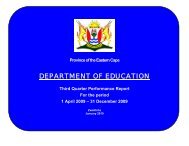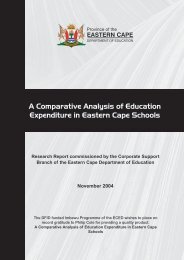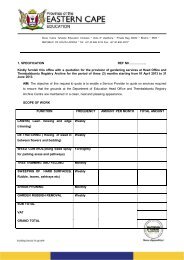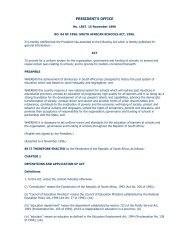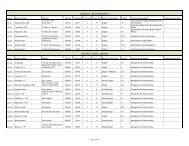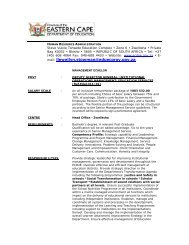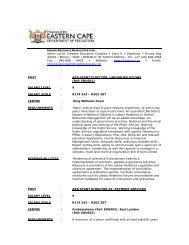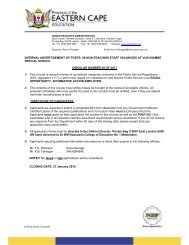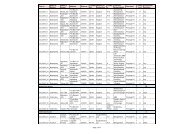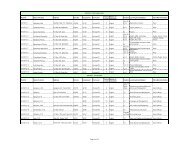national senior certificate grade 12 - Department of Basic Education
national senior certificate grade 12 - Department of Basic Education
national senior certificate grade 12 - Department of Basic Education
Create successful ePaper yourself
Turn your PDF publications into a flip-book with our unique Google optimized e-Paper software.
NATIONAL<br />
SENIOR CERTIFICATE<br />
GRADE <strong>12</strong><br />
ACCOUNTING<br />
NOVEMBER 2008<br />
MARKS: 300<br />
TIME: 3 hours<br />
This question paper consists <strong>of</strong> 21 pages and an answer book <strong>of</strong> 20 pages.<br />
Copyright reserved<br />
Please turn over
Accounting 2 DoE/November 2008<br />
NSC<br />
INSTRUCTIONS AND INFORMATION<br />
Read the following instructions carefully and follow them precisely.<br />
1.<br />
2.<br />
3.<br />
4.<br />
5.<br />
Answer ALL the questions.<br />
A special ANSWER BOOK is provided in which to answer ALL the questions.<br />
Workings must be shown in order to achieve part-marks.<br />
Non-programmable calculators may be used.<br />
You may use a dark pencil or blue/black ink to answer the questions.<br />
Copyright reserved<br />
Please turn over
Accounting 3 DoE/November 2008<br />
NSC<br />
6. Use the information given in the table below as a guide when answering the<br />
question paper. Try NOT to deviate from it.<br />
Topic <strong>of</strong> question:<br />
Company concepts, records and<br />
VAT<br />
QUESTION 1: 35 marks; 20 minutes<br />
Learning outcomes covered:<br />
LO1 Financial accounting<br />
- AS1 Define accounting concepts<br />
- AS2 Record unique information for companies<br />
- AS7 Apply principles <strong>of</strong> VAT<br />
QUESTION 2: 50 marks; 30 minutes<br />
The topic <strong>of</strong> the question is: The Learning outcomes covered:<br />
Budgeting and corporate<br />
governance<br />
LO2 Managerial accounting<br />
- AS3 Analyse and interpret a cash budget<br />
LO3 Managing resources<br />
- AS5 Code <strong>of</strong> ethics<br />
- AS6 Apply internal control and audit processes<br />
Topic <strong>of</strong> question:<br />
Manufacturing<br />
Topic <strong>of</strong> question:<br />
Company reporting<br />
QUESTION 3: 45 marks; 25 minutes<br />
Learning outcomes covered:<br />
LO2 Managerial accounting<br />
- AS2 Prepare, analyse and report cost information<br />
LO3 Managing resources<br />
- AS6 Apply internal control and audit processes<br />
QUESTION 4: 65 marks; 30 minutes<br />
Learning outcomes covered:<br />
LO1 Financial accounting<br />
- AS5 Prepare financial statements<br />
- AS6 Analysing an audit report<br />
LO3 Managing resources<br />
- AS5 Code <strong>of</strong> ethics and role <strong>of</strong> pr<strong>of</strong>essional<br />
bodies<br />
- AS6 Apply internal control and audit processes<br />
Topic <strong>of</strong> question:<br />
Cash flow and interpretation <strong>of</strong> a<br />
company<br />
QUESTION 5: 70 marks; 45 minutes<br />
Learning outcomes covered:<br />
LO1 Financial accounting<br />
- AS5 Prepare and interpret financial statements<br />
LO3 Managing resources<br />
- AS5 Code <strong>of</strong> ethics<br />
QUESTION 6: 35 marks; 30 minutes<br />
Topic <strong>of</strong> question:<br />
Learning outcomes covered:<br />
LO3 Managing resources<br />
- AS3 Interpret and report on asset disposal<br />
Fixed assets and internal control<br />
- AS5 Code <strong>of</strong> ethics<br />
- AS6 Apply internal control and audit processes<br />
Copyright reserved<br />
Please turn over
Accounting 4 DoE/November 2008<br />
NSC<br />
LEAVE THIS PAGE BLANK<br />
FOR ROUGH WORK<br />
Copyright reserved<br />
Please turn over
Accounting 5 DoE/November 2008<br />
NSC<br />
QUESTION 1<br />
COMPANY CONCEPTS, RECORDS AND VAT<br />
(35 marks; 20 minutes)<br />
You are provided with information relating to Garland Limited for the financial<br />
year ended 30 June 2008.<br />
REQUIRED:<br />
1.1 Briefly explain why a company has to have 'Limited' or 'Ltd' in its name. (2)<br />
1.2 Briefly explain why Garland Ltd has to make special entries for VAT in its<br />
books. (2)<br />
1.3 Analyse the transactions for the current financial year in the table<br />
provided. Show the account debited, account credited and the missing<br />
amounts. (25)<br />
1.4 The company plans to issue the remaining unissued shares next year.<br />
1.4.1 How many shares will the company issue? (3)<br />
1.4.2 Gary Garland, the managing director, currently owns 230 000<br />
shares in this company. What is the minimum number <strong>of</strong> shares<br />
Gary will have to buy to keep control <strong>of</strong> the company? (3)<br />
BACKGROUND INFORMATION AND OPENING BALANCES:<br />
• The business was started in 2004 with an authorised share capital <strong>of</strong><br />
500 000 ordinary shares <strong>of</strong> R2,00 par value each.<br />
• By 1 July 2007, the start <strong>of</strong> the current financial year, the business<br />
had issued 300 000 <strong>of</strong> these shares at par.<br />
TRANSACTIONS FOR THE YEAR ENDED 30 JUNE 2008:<br />
Example: Directors' fees <strong>of</strong> R150 000 were paid.<br />
1. Credit purchases <strong>of</strong> trading stock for the year amounted to R350 000,<br />
excluding VAT. The VAT amount is R49 000.<br />
2. Cash sales for the year were R684 000 including VAT <strong>of</strong> 14%. The cost<br />
price <strong>of</strong> these goods was R400 000. The business uses the perpetual<br />
(continuous) inventory system.<br />
3. Provisional tax payments totalling R143 550 were made to SARS.<br />
4. Interim dividends <strong>of</strong> R24 000 were paid to the shareholders.<br />
5. Further <strong>12</strong>0 000 shares were issued at a premium <strong>of</strong> 60 cents each.<br />
6. The tax assessment for income tax for the year amounted to R154 356.<br />
7. A final dividend <strong>of</strong> 17 cents per share was declared.<br />
35<br />
Copyright reserved<br />
Please turn over
Accounting 6 DoE/November 2008<br />
NSC<br />
QUESTION 2<br />
BUDGETING AND CORPORATE GOVERNANCE<br />
(50 marks; 30 minutes)<br />
2.1 PRESENTATION OF A CASH BUDGET<br />
You are the accountant <strong>of</strong> Limpopo Traders and you have prepared the cash<br />
budget for the three months ending 31 March 2009, to present to the owner,<br />
Thabo Mkhize.<br />
REQUIRED:<br />
2.1.1 What is the main purpose <strong>of</strong> preparing a Cash Budget? (2)<br />
2.1.2 At the end <strong>of</strong> October 2008 you identified the following figures. Explain<br />
what you would mention to Thabo about each <strong>of</strong> the following items at<br />
the end <strong>of</strong> October:<br />
October 2008<br />
Budgeted Actual<br />
Repairs and maintenance R23 000 R18 000<br />
Telephone R15 000 R24 000<br />
Rent income R72 000 R22 000<br />
Advertising R25 000 R25 000 (8)<br />
2.1.3 Calculate the total sales that may be expected in February 2009. (4)<br />
2.1.4 Prepare a Debtors Collection Schedule for the period ending<br />
31 March 2009 to check the figures in the Cash Budget. (9)<br />
2.1.5 Thabo is <strong>of</strong> the opinion that it would be a good idea to start selling on<br />
credit, but his shop manager disagrees. Give ONE point from the<br />
question to support Thabo's opinion, and ONE point against his<br />
opinion. Give figures to support your points. (6)<br />
2.1.6 Refer to the complete Cash Budget for the three months ending<br />
31 March 2009 (see below). Thabo cannot understand what the budget<br />
reflects and he asks you to highlight the important aspects.<br />
Explain THREE points other than those mentioned in<br />
QUESTIONS 2.1.2 to 2.1.5 above. Give figures (or ratios/percentages)<br />
from the question to support your explanations. (9)<br />
Copyright reserved<br />
Please turn over
Accounting 7 DoE/November 2008<br />
NSC<br />
INFORMATION:<br />
1. Credit sales: Thabo decides to start selling on credit from 1 February 2009.<br />
Credit sales are expected to comprise 80% <strong>of</strong> all sales. The business uses<br />
a mark-up <strong>of</strong> 50% on cost at all times. Debtors are expected to pay as<br />
follows:<br />
• 10% pay in the same month as the credit sales transaction<br />
• 55% pay in the month following the credit sales transaction month<br />
• 28% pay in the second month following the credit sales transaction<br />
month<br />
• 7% is expected to be irrecoverable (bad debts)<br />
2. Mortgage loan: Thabo decides to take out a mortgage loan on the property<br />
which the business bought for cash many years ago. Interest <strong>of</strong> 15% p.a. is<br />
capitalised (added to loan).<br />
LIMPOPO TRADERS<br />
CASH BUDGET FOR THREE MONTHS ENDING 31 MARCH 2009<br />
2009<br />
JANUARY<br />
2009<br />
FEBRUARY<br />
2009<br />
MARCH<br />
RECEIPTS 675 000 1 176 600 1 093 600<br />
Cash sales 600 000 144 000 162 000<br />
Collection from debtors (see info.1 above) 57 600 381 600<br />
Mortgage loan from ACE Bank (see info.2 above) 900 000<br />
Rent income 72 000 72 000 80 000<br />
Interest on fixed deposit 3 000 3 000<br />
Fixed deposit maturing 470 000<br />
PAYMENTS 771 700 960 470 1 240 780<br />
Purchase <strong>of</strong> stock (all for cash) 400 000 480 000 540 000<br />
Repayment <strong>of</strong> loan and interest 10 370 10 370<br />
Bank charges 13 000 8 000 8 000<br />
Insurance 7 700 7 700 10 010<br />
Salaries 140 000 140 000 168 000<br />
Wages 60 000 62 400 62 400<br />
Telephone 16 000 16 000 16 000<br />
Advertising 15 000 15 000 15 000<br />
Sundry expenses 20 000 21 000 22 000<br />
Purchase <strong>of</strong> vehicles 180 000<br />
Vehicle expenses 9 000<br />
Drawings by Thabo 100 000 200 000 200 000<br />
Surplus (Deficit) for the month (96 700) 216 130 (147 180)<br />
Cash at beginning <strong>of</strong> month 55 000 (41 700) 174 430<br />
Cash at the end <strong>of</strong> the month (41 700) 174 430 27 250<br />
Copyright reserved<br />
Please turn over
Accounting 8 DoE/November 2008<br />
NSC<br />
2.2 CASE STUDY: PRESTIGE HOTELS LTD<br />
You are provided with an extract from a newspaper article which is based on an<br />
actual case.<br />
REQUIRED:<br />
2.2.1 If you were a major shareholder in this company, what questions would<br />
you ask the managing director at the special meeting? Give TWO<br />
questions. (6)<br />
2.2.2 What should the managing director say at the special meeting to defend<br />
the board's decisions about the budget? Briefly explain TWO points. (6)<br />
INFORMATION:<br />
PRESTIGE HOTELS LTD SLAMMED FOR INAPPROPRIATE DECISIONS<br />
[By Helen Brown, Daily Views, 24 Nov. 2007]<br />
The decision by Prestige Hotels Ltd to sponsor the Far East Inter<strong>national</strong> Soccer<br />
tournament to the tune <strong>of</strong> R5 million at a time when the company is seeking extra loans<br />
and finance from investors has been criticised by some <strong>of</strong> the major shareholders and<br />
trade unions.<br />
One <strong>of</strong> the major shareholders, Glyn Schroda, said this week that Prestige Hotels made<br />
an operating loss <strong>of</strong> R83 million during the 2006/2007 financial year and that the budget<br />
for the new year shows huge cash shortfalls. She said that the managing director, Brand<br />
Schoon, needed to be held accountable and would have to explain the actions <strong>of</strong> the<br />
board at a special meeting called by shareholders next week. Trade union<br />
representative, Vally Pradeep, also criticised the company for not looking after its<br />
employees.<br />
Prestige Hotels Ltd is the main sponsor and owns hotels in South Africa and the Far<br />
East. They will be providing free accommodation for players for the Far East<br />
Inter<strong>national</strong> Soccer tournament. Spectators will be required to pay for their own rooms.<br />
'We are taking our strong South African brand to the rest <strong>of</strong> the world with this<br />
sponsorship; we are making our presence felt on the world stage,' said Schoon.<br />
Siswe Mashala, chief accountant <strong>of</strong> the company, said Prestige Hotels had reduced its<br />
sponsorships from more than 40 to only five sporting events and had budgeted for 8%<br />
salary and wage increases.<br />
50<br />
Copyright reserved<br />
Please turn over
Accounting 9 DoE/November 2008<br />
NSC<br />
QUESTION 3<br />
MANUFACTURING<br />
(45 marks; 25 minutes)<br />
3.1 PRODUCTION COST STATEMENT AND INVENTORY SYSTEMS<br />
You are provided with information relating to Valley Bed Manufacturers for the<br />
financial year ended 29 February 2008.<br />
The business produces beds, and sells these at a mark-up <strong>of</strong> 70% on cost. They<br />
use the perpetual (continuous) inventory system for finished goods and the periodic<br />
system for raw materials and indirect materials.<br />
REQUIRED:<br />
• Prepare the Production Cost Statement for the year ended 29 February 2008. (9)<br />
• Provide workings for Direct Materials Costs and Factory Overhead Costs. (16)<br />
INFORMATION:<br />
1. The following balances appeared, amongst others, in the ledger at the<br />
beginning and end <strong>of</strong> the financial year.<br />
1 March 2007 29 February 2008<br />
Raw materials stock 95 000 110 500<br />
Work-in-process stock 71 500 191 600<br />
Finished goods stock 480 000 96 200<br />
Factory indirect materials stock 20 500 18 000<br />
2. Transactions during the year:<br />
• Raw materials purchased on credit, R521 000<br />
• Cost <strong>of</strong> transporting raw materials to the factory, R29 500<br />
• Factory indirect materials bought for cash, R77 500<br />
• Wages paid to factory workers who make the beds, R300 800<br />
• Salary paid to factory foreman (manager), R105 000<br />
• Commission paid to sales staff, R90 000<br />
• Maintenance <strong>of</strong> factory equipment paid, R37 000 (a further R11 000 is still<br />
owed)<br />
• Water and electricity paid, R21 000 (this is to be split between the factory<br />
and the <strong>of</strong>fice in the ratio 4:1)<br />
• Rent paid, R108 000 (this is to be split across the various departments<br />
according to floor area - the factory accounts for 800 square metres out <strong>of</strong><br />
the total area <strong>of</strong> 1 200 square metres)<br />
• Depreciation on factory equipment amounts to R60 500<br />
Copyright reserved<br />
Please turn over
Accounting 10 DoE/November 2008<br />
NSC<br />
LEAVE THIS PAGE BLANK<br />
FOR ROUGH WORK<br />
Copyright reserved<br />
Please turn over
Accounting 11 DoE/November 2008<br />
NSC<br />
3.2 UNIT COSTS<br />
REQUIRED:<br />
3.2.1 Calculate the unit costs for 2008 indicated as (a), (b) and (c) in the<br />
table below. (6)<br />
3.2.2 Compare the unit costs <strong>of</strong> 2008 with those <strong>of</strong> 2007. Some <strong>of</strong> the unit<br />
costs have been affected by inflation (increased prices). In each <strong>of</strong> the<br />
following cases give a possible reason (other than inflation) for the<br />
change:<br />
• Direct materials cost per unit<br />
• Direct labour cost per unit<br />
• Factory overhead costs per unit (6)<br />
3.2.3 Break-even point:<br />
• Calculate the break-even point for 2008.<br />
• Comment on the break-even point calculated above. Should the<br />
business be satisfied with the number <strong>of</strong> units that are currently<br />
being produced? Explain.<br />
(5)<br />
(3)<br />
INFORMATION:<br />
1. Springbok T-Shirt Manufacturers made and sold 34 000 T-shirts during the<br />
year ended 29 February 2008. They produced 25 000 T-shirts in the<br />
previous year.<br />
2. All T-shirts were sold at a fixed price <strong>of</strong> R45 each in 2007 and 2008.<br />
3. All finished items were sold. There was no work-in-process at the<br />
beginning or end <strong>of</strong> the financial year.<br />
4. The following total and unit costs were identified:<br />
2008<br />
34 000 units made<br />
2007<br />
25 000 units made<br />
Total costs Unit costs Total costs Unit costs<br />
Variable costs: R980 000 R28,82 R801 000 R32,04<br />
Direct materials cost 500 000 (a) 462 000 18,48<br />
Direct labour cost 320 000 9,41 205 000 8,20<br />
Selling and distribution<br />
cost 160 000 (b) 134 000 5,36<br />
Fixed costs: 333 000 9,79 296 000 11,84<br />
Factory overhead costs 205 000 (c) 205 000 8,20<br />
Administration cost <strong>12</strong>8 000 3,76 91 000 3,64<br />
Total costs R1 313 000 R38,62 R1 097 000 R43,88<br />
45<br />
Copyright reserved<br />
Please turn over
Accounting <strong>12</strong> DoE/November 2008<br />
NSC<br />
QUESTION 4<br />
COMPANY REPORTING<br />
(65 marks; 30 minutes)<br />
4.1 INCOME STATEMENT<br />
You are provided with information relating to Samora Sports Limited. The company<br />
sells sports equipment and repairs equipment for their customers.<br />
REQUIRED:<br />
Prepare the Income Statement for the year ended 30 June 2008 after taking all the<br />
adjustments and additional information into account. (50)<br />
INFORMATION:<br />
1. Figures extracted from the Pre-Adjustment Trial Balance on 30 June 2008:<br />
Ordinary share capital (R5 par value) R 1 200 000<br />
Fixed deposit 160 000<br />
Trading stock 215 000<br />
Debtors control 39 090<br />
Equipment (for <strong>of</strong>fice and shop) 224 000<br />
Accumulated depreciation on <strong>of</strong>fice and shop<br />
equipment 130 000<br />
Mortgage loan from Credbank 281 200<br />
Sales 1 703 200<br />
Debtors allowances 17 000<br />
Cost <strong>of</strong> sales ?<br />
Service fee income (in respect <strong>of</strong> repair services) 297 140<br />
Rent income 105 000<br />
Interest income 11 200<br />
Salaries and wages 234 750<br />
Employers' contributions to Pension Fund and UIF 53 200<br />
Audit fees 30 000<br />
Directors fees 230 000<br />
Consumable stores 51 100<br />
Bank charges 5 240<br />
Sundry expenses ?<br />
2. Adjustments and additional information:<br />
The auditors have identified the following errors or omissions:<br />
2.1 The auditors are owed a further R28 000 after completing the audit.<br />
2.2 Bank charges <strong>of</strong> R310 reflected on the June 2008 bank statement have<br />
not yet been entered in the books.<br />
Copyright reserved<br />
Please turn over
Accounting 13 DoE/November 2008<br />
NSC<br />
2.3 A credit note issued to a debtor, A Mona, dated 28 June 2008 was not<br />
recorded in the books. The credit note was for:<br />
• Goods returned by A Mona, R 6 200 (the cost was R4 800)<br />
• Price reduction on unsatisfactory repair <strong>of</strong> a tennis racket, R540<br />
2.4 The stock count on 30 June 2008 revealed the following on hand:<br />
• Trading stock, R202 000<br />
• Consumable stores, R900<br />
2.5 An employee was left out <strong>of</strong> the Salaries Journal for June 2008. The details<br />
from his pay-slip were:<br />
Gross salary R6 000<br />
PAYE deduction (18%) (1 080)<br />
Pension deduction (7,5%) (450)<br />
UIF (60)<br />
Net salary R4 410<br />
The business contributions were:<br />
• Pension Fund: 10,5% <strong>of</strong> gross salary<br />
• UIF: Rand-for-rand basis<br />
2.6 The tenant paid the July and August rent in June 2008. The rent was<br />
increased by R700 per month on 1 January 2008.<br />
2.7 Provide for depreciation on <strong>of</strong>fice and shop equipment at 10% p.a. on the<br />
diminishing-balance method. Note that new shop equipment costing<br />
R30 000 was purchased half-way through the financial year (this was<br />
properly recorded).<br />
2.8 Interest on the loan was capitalised. The loan statement from Credbank on<br />
30 June 2008 reflects the following:<br />
CREDBANK<br />
Loan statement on 30 June 2008<br />
Balance on 1 July 2007 R332 800<br />
Interest charged ?<br />
Monthly payments to Credbank in terms <strong>of</strong> the loan<br />
agreement (<strong>12</strong> months x R4 300)<br />
R 51 600<br />
Balance on 30 June 2008 R326 000<br />
The interest expense for the year has not yet been entered in the books.<br />
2.9 Use the following percentages to calculate the missing figures:<br />
• Mark-up % achieved: 60% on cost<br />
• Operating pr<strong>of</strong>it on sales: 20%<br />
• Income tax rate: 30% <strong>of</strong> net pr<strong>of</strong>it<br />
Copyright reserved<br />
Please turn over
Accounting 14 DoE/November 2008<br />
NSC<br />
4.2 CORPORATE GOVERNANCE AND AUDITING<br />
The following audit report was issued by the auditors <strong>of</strong> Samora<br />
Sports Ltd:<br />
Audit opinion – To the shareholders:<br />
In our opinion, the financial statements fairly present, in all material respects, the<br />
financial position <strong>of</strong> the company and the group at 30 June 2008 and the results <strong>of</strong><br />
their operations and cash flows for the year ended, in accordance with Inter<strong>national</strong><br />
Financial Reporting Standards, and in the manner required by the Companies Act<br />
in South Africa.<br />
I.M. Wright & Associates<br />
Chartered Accountants (SA)<br />
Registered Accountants and Auditors<br />
Pretoria 10 August 2008<br />
4.2.1 Why does the Companies Act make it a requirement for public<br />
companies to be audited? (2)<br />
4.2.2 Although this audit opinion is addressed to the shareholders,<br />
other interested persons will also want to read it.<br />
Name ONE other person who would be interested in this audit<br />
opinion, and give a reason for his/her interest in the opinion. (3)<br />
4.2.3 At the AGM, one <strong>of</strong> the shareholders says that he is not happy<br />
with the words 'fairly present' in the audit report. He wants the<br />
auditors to say that the financial statements are 'correct in all<br />
respects'.<br />
What explanation should be given to this shareholder? State<br />
ONE point. (3)<br />
4.2.4 The directors are not happy with the high audit fees reflected<br />
in the Income Statement.<br />
Explain why improvement in internal control will have a<br />
positive effect on the external auditors' fees. State ONE point. (3)<br />
4.2.5 SAICA is one <strong>of</strong> the main pr<strong>of</strong>essional bodies governing<br />
accountants in this country.<br />
Explain TWO <strong>of</strong> the main roles performed by SAICA. (4)<br />
65<br />
Copyright reserved<br />
Please turn over
Accounting 15 DoE/November 2008<br />
NSC<br />
QUESTION 5<br />
CASH FLOW AND INTERPRETATION OF A COMPANY<br />
(70 marks; 45 minutes)<br />
You are provided with information relating to Glebo Limited for the year ended<br />
30 June 2008. Glebo Limited is a public company listed on the JSE Securities<br />
Exchange. They are based in Pretoria and they sell <strong>of</strong>fice stationery.<br />
The directors <strong>of</strong> Glebo Limited decided to open new branches in Bloemfontein and<br />
Witbank halfway through the year.<br />
Note:<br />
• Answer the questions below.<br />
• Where you are asked to comment on financial indicators you must quote<br />
the name <strong>of</strong> the relevant indicator as well as the figure, which is provided<br />
or calculated in the question for that indicator.<br />
Copyright reserved<br />
Please turn over
Accounting 16 DoE/November 2008<br />
NSC<br />
REQUIRED:<br />
5.1 Calculate the following financial indicators for 2008:<br />
5.1.1 Debt/Equity ratio (3)<br />
5.1.2 Acid-test ratio (4)<br />
5.1.3 Stock turnover rate (4)<br />
5.1.4 % return on average shareholders' equity (after tax) (4)<br />
5.1.5 Net asset value per share (4)<br />
5.2 Solvency and liquidity:<br />
5.2.1 Briefly explain the difference between solvency and liquidity. (2)<br />
5.2.2 Comment on the solvency <strong>of</strong> this business. Quote a financial<br />
indicator from the question to support your opinion. (3)<br />
5.2.3 Comment on the liquidity <strong>of</strong> this business. Quote the financial<br />
indicators and the changes (trends) from the previous year to<br />
support your opinion. (10)<br />
5.3 Returns and share price:<br />
5.3.1 Comment on the earnings, dividends and % return. Quote<br />
financial indicators and the changes (trends) from the previous<br />
year to support your opinion. (6)<br />
5.3.2 You have been a shareholder since the company started many<br />
years ago. The price <strong>of</strong> the share on the JSE is now 350 cents<br />
which is a 6% increase over the past year. Would you be satisfied<br />
with the performance <strong>of</strong> the share price? Comment and compare<br />
this to a financial indicator from the question to support your<br />
opinion. (4)<br />
5.4 Calculate the missing figures in the Cash Flow Statement. The missing<br />
figures are indicated (a) to (e). (<strong>12</strong>)<br />
5.5 The Cash Flow Statement highlights some significant (important)<br />
decisions taken by the directors over the past year. Explain TWO <strong>of</strong><br />
these significant decisions. Quote figures to support your answer. Also<br />
explain how these decisions would benefit the company and the<br />
shareholders. (8)<br />
5.6 At the AGM, the directors announce that the company will:<br />
- Conduct training <strong>of</strong> all employees in terms <strong>of</strong> morals and ethics<br />
- Donate funds towards cleaning up the environment<br />
Explain why this is necessary although this will cost the company a lot <strong>of</strong><br />
money each year. State THREE points. (6)<br />
Copyright reserved<br />
Please turn over
Accounting 17 DoE/November 2008<br />
NSC<br />
INFORMATION:<br />
GLEBO LIMITED<br />
EXTRACT FROM INCOME STATEMENT FOR THE YEAR ENDED 30 JUNE 2008<br />
2008 2007<br />
Sales (70% <strong>of</strong> sales were on credit) 9 000 000 7 000 000<br />
Cost <strong>of</strong> sales 5 625 000 4 070 000<br />
Operating pr<strong>of</strong>it 1 423 200 947 600<br />
Income tax 426 000 270 000<br />
Net pr<strong>of</strong>it after tax 904 000 630 000<br />
GLEBO LIMITED<br />
BALANCE SHEET AS AT 30 JUNE 2008<br />
2008 2007<br />
ASSETS<br />
Non-current assets 4 626 000 2 209 000<br />
Fixed assets 4 326 000 1 489 000<br />
Financial assets 300 000 720 000<br />
Current assets 2 557 000 2 508 000<br />
Inventories (all trading stock) 1 640 000 1 510 000<br />
Trade and other receivables (all trade debtors) 810 000 960 000<br />
SARS (Income tax) 0 18 000<br />
Cash and cash equivalents 107 000 20 000<br />
TOTAL ASSETS 7 183 000 4 717 000<br />
EQUITY AND LIABILITIES<br />
Ordinary shareholders' equity 4 <strong>12</strong>3 000 2 640 000<br />
Ordinary share capital (R2,00 par value) 2 200 000 1 600 000<br />
Share premium 710 000 200 000<br />
Retained income 1 213 000 840 000<br />
Non-current liabilities 1 980 000 700 000<br />
Mortgage loan: Jozi Bank (13% p.a.) 1 980 000 700 000<br />
Current liabilities 1 080 000 1 377 000<br />
Trade and other payables (all trade creditors) 705 000 819 000<br />
SARS (Income tax) 32 000 0<br />
Shareholders for dividends 275 000 240 000<br />
Bank overdraft 0 250 000<br />
Current portion <strong>of</strong> loan 68 000 68 000<br />
TOTAL EQUITY AND LIABILITIES 7 183 000 4 717 000<br />
Copyright reserved<br />
Please turn over
Accounting 18 DoE/November 2008<br />
NSC<br />
FINANCIAL INDICATORS:<br />
The following financial indicators were calculated for the past two years:<br />
2008 2007<br />
Debt/Equity ratio ? 0,27:1<br />
Total assets to total liabilities 2,2:1 2,3:1<br />
Current ratio 2,4:1 1,8:1<br />
Acid-test ratio ? 0,7:1<br />
Stock-turnover rate ? 2,4 times<br />
Debtors collection period 51 days 72 days<br />
Creditors payment period 49 days 67 days<br />
% return on average shareholders' equity (after tax) ? 23,9 %<br />
% return on total capital employed (before tax) 43,3 % 39,7 %<br />
Net asset value per share ? 330 cents<br />
Dividends per share 57 cents 65 cents<br />
Earnings per share 95,2 cents 78,8 cents<br />
Copyright reserved<br />
Please turn over
Accounting 19 DoE/November 2008<br />
NSC<br />
GLEBO LIMITED<br />
CASH-FLOW STATEMENT FOR THE YEAR ENDED 30 JUNE 2008<br />
Cash effects <strong>of</strong> operating activities 744 000<br />
Cash generated from operations ?<br />
Interest paid (134 000)<br />
Dividends paid (496 000)<br />
Income tax paid (a) ?<br />
Cash effects <strong>of</strong> investing activities (3 217 000)<br />
Purchase <strong>of</strong> fixed assets for new branches (3 357 000)<br />
Proceeds <strong>of</strong> sale <strong>of</strong> fixed assets 140 000<br />
Cash effects <strong>of</strong> financing activities 2 810 000<br />
Proceeds <strong>of</strong> issue <strong>of</strong> shares (b) ?<br />
Proceeds <strong>of</strong> increase in mortgage loan (c) ?<br />
Proceeds <strong>of</strong> financial assets matured 420 000<br />
Net change in cash equivalents (d) ?<br />
Cash equivalents – beginning <strong>of</strong> year (230 000)<br />
Cash equivalents – end <strong>of</strong> year (e) ?<br />
70<br />
Copyright reserved<br />
Please turn over
Accounting 20 DoE/November 2008<br />
NSC<br />
QUESTION 6<br />
FIXED ASSETS AND INTERNAL CONTROL<br />
(35 marks; 30 minutes)<br />
You are provided with information in respect <strong>of</strong> Bloemfontein Hardware for the<br />
year ended 29 February 2008. The business is owned by Mike Moore and Milly<br />
Miles.<br />
REQUIRED:<br />
6.1 Prepare the Asset Disposal Account for <strong>of</strong>fice equipment (computers)<br />
stolen on 30 June 2007 (see information 1 below). (<strong>12</strong>)<br />
6.2 One <strong>of</strong> the <strong>of</strong>fice employees, Di Vulge, knows that the insurance policy only<br />
covers theft if there is evidence <strong>of</strong> forced entry. She also knows that Mike<br />
broke the security gate <strong>of</strong> the <strong>of</strong>fice to make the incident look like forced<br />
entry. She is not sure if Milly knows about this.<br />
What advice would you give Di? Explain ONE point. (3)<br />
6.3 Explain how and why the Fixed Assets Register will assist the internal<br />
auditor in his duties. (3)<br />
6.4 In order to solve their cash flow problems, Mike has sold a portion <strong>of</strong> the<br />
premises at cost price. Milly disagrees with him on this.<br />
Do you support Milly's opinion? Give a reason. (3)<br />
6.5 The business owns three delivery vehicles. Refer to the information in<br />
respect <strong>of</strong> each delivery vehicle from the Fixed Asset Register (see<br />
information 4 below).<br />
• Identify the cost price <strong>of</strong> delivery vehicle 3.<br />
• Explain why delivery vehicle 2 is shown at a book value <strong>of</strong> R1,00 (one<br />
rand).<br />
(3)<br />
(2)<br />
6.6 As a service to their customers, the business delivers goods within<br />
Bloemfontein. They charge a flat rate <strong>of</strong> R250 per delivery. Clients pay<br />
cash directly to the drivers.<br />
A total <strong>of</strong> 3 680 deliveries was done during the year. The delivery service<br />
operated on 260 days during the year.<br />
You are the internal auditor and you are concerned about possible<br />
problems relating to the delivery vehicles and their drivers.<br />
Refer to the information in point 4 below. Identify and explain ONE major<br />
problem relating to each delivery vehicle or its driver. Quote figures from the<br />
information to support your answer. Provide a valid solution to each<br />
problem. (9)<br />
Copyright reserved<br />
Please turn over
Accounting 21 DoE/November 2008<br />
NSC<br />
INFORMATION:<br />
1. Office equipment and disposals:<br />
Office equipment includes the <strong>of</strong>fice computers. Six <strong>of</strong> the <strong>of</strong>fice computers were<br />
stolen on 30 June 2007. These six computers were originally bought at a cost price <strong>of</strong><br />
R13 200 each. The insurance company, Ace Insurers, only paid out R5 000 for each<br />
computer. These computers were replaced at a higher price on 31 August 2007.<br />
2. Delivery vehicles:<br />
The business owns three delivery vehicles that they use to generate their income.<br />
3. Information from the financial statements for year ended 29 February 2008:<br />
FIXED ASSETS<br />
Land & Office Vehicles<br />
buildings equipment<br />
Carrying value at beginning <strong>of</strong> year 1 200 000 630 000 403 501<br />
Cost 1 200 000 980 000 699 000<br />
Accumulated depreciation (350 000) (295 499)<br />
Movements (700 000) 19 560 (111 000)<br />
Additions 240 000<br />
Disposals at carrying value (700 000) (63 360)<br />
Depreciation (157 080) (111 000)<br />
Carrying value at end <strong>of</strong> year 500 000 649 560 292 501<br />
Cost 500 000 1 140 800 699 000<br />
Accumulated depreciation (491 240) (406 499)<br />
4. Information from the Fixed Assets Register and the accounting records on<br />
29 February 2008:<br />
Fixed Assets Register<br />
Delivery vehicle<br />
1<br />
Delivery vehicle<br />
2<br />
Delivery vehicle<br />
3<br />
Date purchased 1 April 2007 1 January 1999 1 April 2005<br />
Cost price <strong>of</strong> vehicle R315 000 R144 000 ?<br />
Accumulated depreciation R94 500 R143 999 R168 000<br />
Carrying value R220 500 R1 R72 000<br />
Information from the<br />
accounting records<br />
Delivery vehicle<br />
1<br />
Delivery vehicle<br />
2<br />
Delivery vehicle<br />
3<br />
Name <strong>of</strong> driver Solly Themba Goldie<br />
Number <strong>of</strong> days worked 210 days 260 days 260 days<br />
Number <strong>of</strong> deliveries done 280 deliveries 2 100 deliveries 1 300 deliveries<br />
Cash paid in by drivers R70 000 R525 000 R275 000<br />
Salary paid to drivers R52 000 R52 000 R52 000<br />
Fuel and maintenance costs for the<br />
year R36 400 R430 500 R201 500<br />
Fuel and maintenance costs per<br />
kilometre R1,30 R2,05 R1,55<br />
35<br />
TOTAL: 300<br />
Copyright reserved


